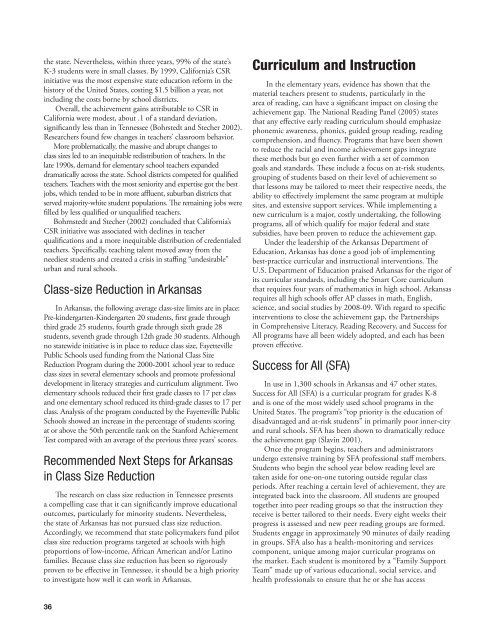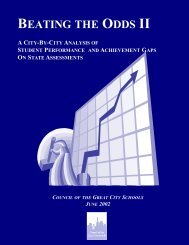WHAT IS ARKANSAS DOING TO CLOSE THE ACHIEVEMENT GAP?
WHAT IS ARKANSAS DOING TO CLOSE THE ACHIEVEMENT GAP?
WHAT IS ARKANSAS DOING TO CLOSE THE ACHIEVEMENT GAP?
You also want an ePaper? Increase the reach of your titles
YUMPU automatically turns print PDFs into web optimized ePapers that Google loves.
the state. Nevertheless, within three years, 99% of the state’s<br />
K-3 students were in small classes. By 1999, California’s CSR<br />
initiative was the most expensive state education reform in the<br />
history of the United States, costing $1.5 billion a year, not<br />
including the costs borne by school districts.<br />
Overall, the achievement gains attributable to CSR in<br />
California were modest, about .1 of a standard deviation,<br />
significantly less than in Tennessee (Bohrstedt and Stecher 2002).<br />
Researchers found few changes in teachers’ classroom behavior.<br />
More problematically, the massive and abrupt changes to<br />
class sizes led to an inequitable redistribution of teachers. In the<br />
late 1990s, demand for elementary school teachers expanded<br />
dramatically across the state. School districts competed for qualified<br />
teachers. Teachers with the most seniority and expertise got the best<br />
jobs, which tended to be in more affluent, suburban districts that<br />
served majority-white student populations. The remaining jobs were<br />
filled by less qualified or unqualified teachers.<br />
Bohrnstedt and Stecher (2002) concluded that California’s<br />
CSR initiative was associated with declines in teacher<br />
qualifications and a more inequitable distribution of credentialed<br />
teachers. Specifically, teaching talent moved away from the<br />
neediest students and created a crisis in staffing “undesirable”<br />
urban and rural schools.<br />
Class-size Reduction in Arkansas<br />
In Arkansas, the following average class-size limits are in place:<br />
Pre-kindergarten-Kindergarten 20 students, first grade through<br />
third grade 25 students, fourth grade through sixth grade 28<br />
students, seventh grade through 12th grade 30 students. Although<br />
no statewide initiative is in place to reduce class size, Fayetteville<br />
Public Schools used funding from the National Class Size<br />
Reduction Program during the 2000-2001 school year to reduce<br />
class sizes in several elementary schools and promote professional<br />
development in literacy strategies and curriculum alignment. Two<br />
elementary schools reduced their first grade classes to 17 per class<br />
and one elementary school reduced its third-grade classes to 17 per<br />
class. Analysis of the program conducted by the Fayetteville Public<br />
Schools showed an increase in the percentage of students scoring<br />
at or above the 50th percentile rank on the Stanford Achievement<br />
Test compared with an average of the previous three years’ scores.<br />
Recommended Next Steps for Arkansas<br />
in Class Size Reduction<br />
The research on class size reduction in Tennessee presents<br />
a compelling case that it can significantly improve educational<br />
outcomes, particularly for minority students. Nevertheless,<br />
the state of Arkansas has not pursued class size reduction.<br />
Accordingly, we recommend that state policymakers fund pilot<br />
class size reduction programs targeted at schools with high<br />
proportions of low-income, African American and/or Latino<br />
families. Because class size reduction has been so rigorously<br />
proven to be effective in Tennessee, it should be a high priority<br />
to investigate how well it can work in Arkansas.<br />
Curriculum and Instruction<br />
In the elementary years, evidence has shown that the<br />
material teachers present to students, particularly in the<br />
area of reading, can have a significant impact on closing the<br />
achievement gap. The National Reading Panel (2005) states<br />
that any effective early reading curriculum should emphasize<br />
phonemic awareness, phonics, guided group reading, reading<br />
comprehension, and fluency. Programs that have been shown<br />
to reduce the racial and income achievement gaps integrate<br />
these methods but go even further with a set of common<br />
goals and standards. These include a focus on at-risk students,<br />
grouping of students based on their level of achievement so<br />
that lessons may be tailored to meet their respective needs, the<br />
ability to effectively implement the same program at multiple<br />
sites, and extensive support services. While implementing a<br />
new curriculum is a major, costly undertaking, the following<br />
programs, all of which qualify for major federal and state<br />
subsidies, have been proven to reduce the achievement gap.<br />
Under the leadership of the Arkansas Department of<br />
Education, Arkansas has done a good job of implementing<br />
best-practice curricular and instructional interventions. The<br />
U.S. Department of Education praised Arkansas for the rigor of<br />
its curricular standards, including the Smart Core curriculum<br />
that requires four years of mathematics in high school. Arkansas<br />
requires all high schools offer AP classes in math, English,<br />
science, and social studies by 2008-09. With regard to specific<br />
interventions to close the achievement gap, the Partnerships<br />
in Comprehensive Literacy, Reading Recovery, and Success for<br />
All programs have all been widely adopted, and each has been<br />
proven effective.<br />
Success for All (SFA)<br />
In use in 1,300 schools in Arkansas and 47 other states,<br />
Success for All (SFA) is a curricular program for grades K-8<br />
and is one of the most widely used school programs in the<br />
United States. The program’s “top priority is the education of<br />
disadvantaged and at-risk students” in primarily poor inner-city<br />
and rural schools. SFA has been shown to dramatically reduce<br />
the achievement gap (Slavin 2001).<br />
Once the program begins, teachers and administrators<br />
undergo extensive training by SFA professional staff members.<br />
Students who begin the school year below reading level are<br />
taken aside for one-on-one tutoring outside regular class<br />
periods. After reaching a certain level of achievement, they are<br />
integrated back into the classroom. All students are grouped<br />
together into peer reading groups so that the instruction they<br />
receive is better tailored to their needs. Every eight weeks their<br />
progress is assessed and new peer reading groups are formed.<br />
Students engage in approximately 90 minutes of daily reading<br />
in groups. SFA also has a health-monitoring and services<br />
component, unique among major curricular programs on<br />
the market. Each student is monitored by a “Family Support<br />
Team” made up of various educational, social service, and<br />
health professionals to ensure that he or she has access<br />
36






